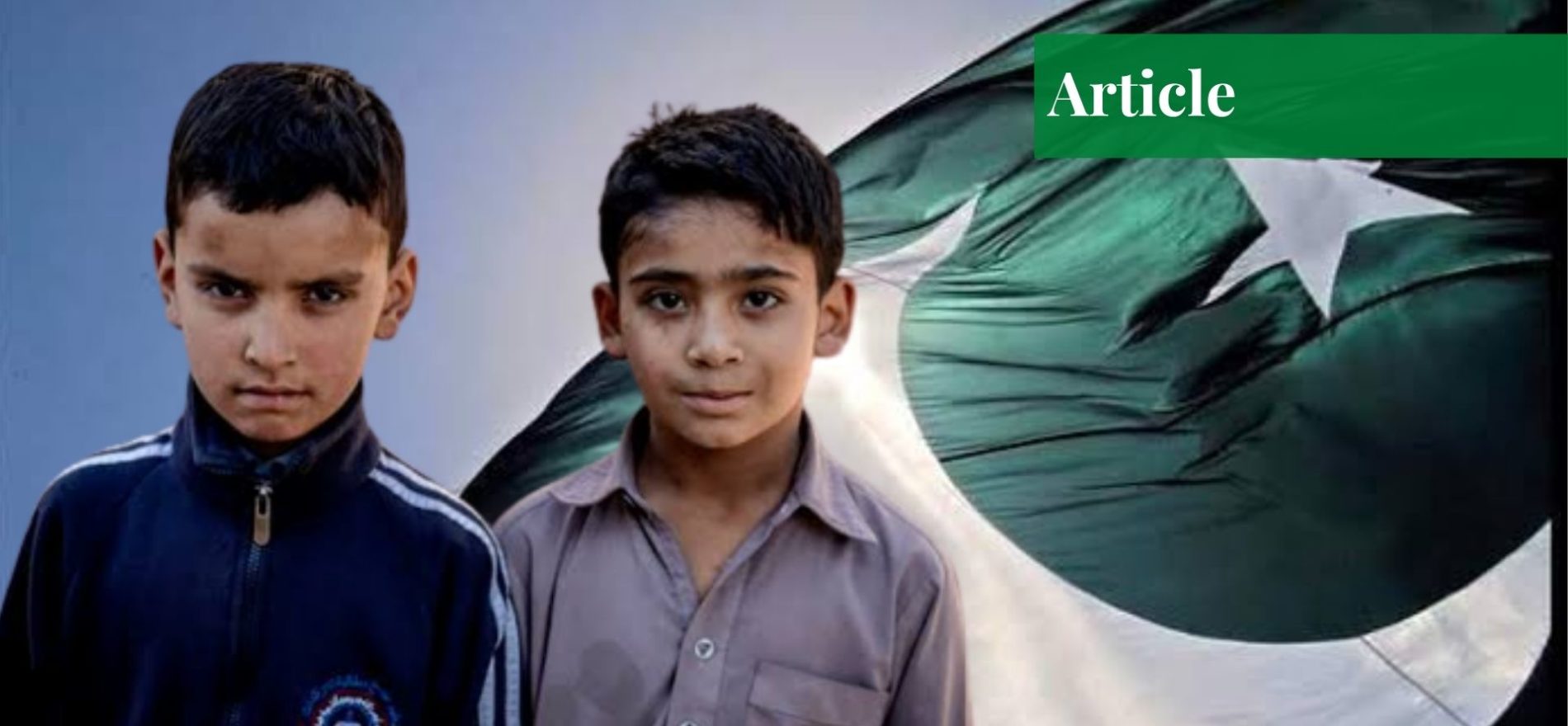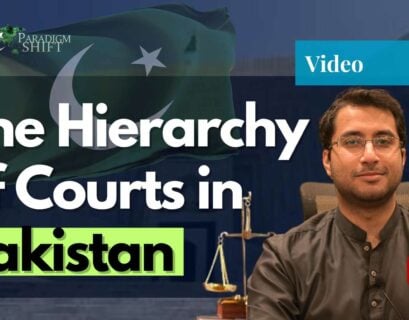Rida Zaman is a law graduate of Bahria University. She is currently practising in Islamabad.
Formation of the Juvenile Justice System Act, 2018
In this era of progressing human rights, justice for all stands as a vigorous concern globally. Child rights, albeit, have netted contemplation for years now, the obstacles persist. The Juvenile Justice System Act (JJSA), 2018, was put forth with an agenda to repeal the former ordinance, by expunging the gaps it inhered. However, whether there has been an expunction of prior lacunas is a debatable subject.
The Juvenile Justice System Ordinance (JJSO), 2000, as well as the Juvenile Justice System Act, 2018 came up in harmony with the UN Convention on the Rights of the Child (UNCRC) and other international instruments, including the Nelson Mandela Rules and the Beijing Rules, with an apparent intent to safeguard the rights of children and shield their juvenility—which is undeniably vital. However, it unbolts the door for variant voids.
JJSO 2000, was repealed in consultation with a judgment of the Lahore High Court in the case of Ahmed Farooq v Federation of Pakistan. The judgment paves a milestone in accentuating the inadequacies carried by the ordinance, leading to the formulation of a new legislative document. Though it was overtly argued that the JJSO was nothing but unconstitutional, impractical, absurd, obscure, and unreasonable, as plentiful provisions of the said Ordinance aided in proliferating dilemma, it remained in force until the promulgation of JJSA, 2018.
Owing to reasons depicted in the previous context, the necessity for a new legislative document was central. Hence, the Juvenile Justice System Act was assented to by the president in 2018. Although applauded generously by a layman, it has an absence of pragmatism.
The socio-economic conditions of India and Bangladesh are indubitably akin to those in Pakistan, moreover, their positive evolution on child rights and the juvenile system is a paramount concern for Pakistan. The system hankers for furtherance, counting both legislation as well as enforcement alterations. Hence, it is in dire need to extract the best practices of its neighboring countries for implementation.
Salient Features of JJSA 2018
Categorizing Offenses
In accordance with the definition provided by the UNCRC, the JJSA defines a “child” as a person who has not attained 18 years of age. No significant change was brought about in this respect, as JJSO 2000 also declared 18 years of age as a yardstick to verify juvenility. The act classifies criminal offenses into three categories: minor, major, and heinous offenses. Minor includes offenses for which maximum punishment under the Pakistan Penal Code (PPC) is up to 3 years, with or without a fine.
While major offenses comprise those for which punishment under PPC lasts from 3 to 7 years, with or without a fine. Lastly, heinous offenses include offenses that are serious, brutal, or shocking to public morality and which are punished under PPC with imprisonment for life or for more than 7 years, with or without a fine.
Legal Assistance & Observation Homes
Besides affixing the age of juvenility and categorizing the offenses, the act further alludes to the provision of the right to legal assistance which has also been enumerated under Rule 7 of Beijing Rules. Under this concerned act, every juvenile shall have the right to legal assistance at the expense of the state. He shall be versed in this right within 24 hours of taking him into custody.
Furthermore, section 20 of the act calls for the establishment of observation homes, declaring them as places where juveniles are confined momentarily after being apprehended by police as well as after procurement of remand from a juvenile court, or otherwise for conducting inquiry or investigation. The said homes are to be made distinctly from police stations.
Creation of Juvenile Rehabilitation Centres
It also stances on the formulation of juvenile rehabilitation centres under section 20 of the concerned act along with the aforementioned observation homes. A juvenile rehabilitation centre is a distinct kind of prison to be established solely for juvenile offenders. The convicted minor shall reside in such premises till he reaches adulthood.
He shall be afforded with prospects to acquire education, as it stands as a guaranteed fundamental right under article 25 A of the constitution, and vocational and technical training for his nurturement. The JJSA 2018 further provided that female juveniles shall be equipped with women’s care centers.
Additionally, a juvenile justice committee shall perform an inspection of observation homes and juvenile rehabilitation centres and issue directions to concerned authorities for welfare and social re-integration. The committee is to consist of 4 members, including a serving magistrate with powers prescribed under section 30 of the Code of Criminal Procedure, a district public prosecutor, a member of the local bar having at least 7 years of experience, and a serving probation officer or social welfare officer not below BPS-17.
Determining the Age of the Alleged Offender
Another striking provision includes the “determination of age” mechanism. The act makes it compulsory for the officer in charge or the investigating officer to conduct inquiries to determine the age of an alleged offender, who physically appears or claims to be a minor. Age determination modes have also been veiled, including birth certificates, educational certificates, and other concerned documents.
Furthermore, the Juvenile Justice System Act, 2018 prioritizes the protection of women by granting them additional safeguards. A female juvenile shall not be dealt with by a male investigating officer, nor shall she be made to dwell in male observation homes.
Besides their specific privileges, a child shall not be tried for an offense with an adult, as similarly enshrined under Rule 11(d) of the Nelson Mandela Rules, nor will his proceedings be made public, to protect his dignity which stands as a fundamental right under Article 14 of the Constitution of Pakistan and under Rule 8 of the Beijing Rules.
Shortcomings of the Juvenile Justice System Act, 2018
Although the Juvenile Justice System Act, 2018, lectures guarantees for juveniles, it lags in exterminating delinquencies overall. Following are the few limitations that the act miscarries, hence defeating its purpose.
1. Flaws of the Age Determination Mechanism
The JJSA 2018 declares eighteen years of age as the age of juvenility, hence, proclaiming every human being who falls below the prescribed age criteria a “child.” The affixation gathered ample reverence, nevertheless, it stands as a gateway to the commission of illegal acts. Maturity, not an absolute standard, diverges from one subject to another, as pinpointed in the Lahore High Court judgment of Farooq Ahmed v Federation of Pakistan.
Furthermore, India, after the infamous 2012 Delhi gang-rape case also known as the “Nirabhaya Case,” amended its former laws, thus inaugurating a fresh legislative instrument, covering the paucity of the former laws. The act came up amid immense revolt, after a 17-year-old was acquitted of murder by a plea of juvenility, the victim’s mother voiced grave agitation.
The law-making bodies, earnestly dissecting the issues, thus, enacted the formulation of psychological bodies to opine if a child had an adequate understanding of the acts he so committed. Evoking the plea of juvenility as a rationale for exoneration is used as a tool by many in Pakistan.
Determination of age is the footing for invoking this exact plea, judgments after judgments edict on modes of age determination, but the law spawns perplexity, by scanting in imposing a substantive rule. In Sultan Ahmed’s case, the court declared that irrespective of whether the issue of juvenility is raised before the court, the presiding officer is to conduct an inquiry for the production of relevant documents, and the summoning of persons and medical reports, etc. for such determination.
However, in the judgment of Muhammad Aslam’s case, the court overtly ordered that mere production of a school leaving certificate does not account for juvenility. Determination of juvenility is a subjective concern, varying from one child’s level of maturity to the other, hence affording the option of instituting a physiological panel.
The infamous Lahore High Court Judgement, PLD 2005 Lah.15, stresses the inefficiencies in the age determination mechanism, regarding it as a gateway to corrupt practices. In order to claim juvenility, documents are forged, fake medical certificates are furnished, false school leaving certificates are documented, enhancing the crime commission.
2. Inability to Establish Doli Incapax
The Juvenile Justice System Act, 2018 disregards epitomizing the concept of doli incapax. This principle of criminal jurisprudence catches its root in Article 40 (3)(a) of UNCRC. According to it, every country must append the minimum age for children who ought to be vindicated from any kind of criminal liability, considering their powerlessness to decipher the nature and consequences of the act. Section 82 and 83 of the PPC do comply with the principle of UNCRC, however, the JJSA 2018 neglects this jurisprudential principle of criminal law, proving to be inconsistent.
3. Training of Special Police Official
Rule 12 of the Beijing Rules baits attention on necessitating specialized training of law enforcement officials concerned with the administration of justice. As a police officer is directly tangled in the investigation of juveniles, it is mandated on the parliament to come up with provisions for the education and training of concerned individuals.
India rightly encrypted such rules in its legislative document, thus, devolving special police officials for juveniles. However, the JJSA 2018, deserted in regulating provisions as to special police officials for juveniles, neither did it provide for their training or education. It merely drafted on the requirement of an additional social welfare officer to aid in the investigation—something that’s blatantly insufficient.
4. Lack of juvenile Courts
Besides, the act bears guaranteed infrastructural deficiencies, triggering concerns. After a substantial proportion of time, the state still lags in setting up obligatory juvenile courts. Standing as an alarming concern, the state has been documented to set up as few as 13 juvenile courts throughout Pakistan. The legislation, though, dictates otherwise, children are being tried in ordinary courts ever since.
Wistfully, Islamabad – the capital of Pakistan – does not provide the record of a single juvenile court. Moving further, the setting up of juvenile justice committees is endorsed under section 12 of the JJSA 2018. Even after a year had passed, no such committee had been formed; the process of creating these committees has been incredibly slow.
5. Observations Homes
The Juvenile Justice System Act, 2018 further guarantees the establishment of observation homes, as places where juveniles can be kept momentarily after arrest or during physical remand, leaving palpable questions unanswered. For instance, who will provide and subsequently manage these homes? Will these homes function as independent places or as designated places with concerned police authority? What sort of paraphernalia will be attached to this place?
Ever since the inception of JJSA, no observation home is evident on record, juveniles are arrested and locked up in cells like those of adults, abetting the juveniles with occasions to master from adult felons, enhancing violence and elevating the crime ratio. Naturally, if a child of tender age and mind is confined in an ordinary court, he, after being released, shall take his frustrations out in rigorous modes owing to the circumstances afforded to him in ordinary prisons.
Thusly, the condition of detention of juvenile offenders in Pakistan is abysmal. Children, housed with adult prisoners are subjected to torture, harassment, and sexual abuse, obstructing the very idea of the juvenile system.
6. The Need for Rehabilitation
Whereas flanking realms are fitted with operative rehabilitation centers for children. In Bangladesh, child development centers (CDCs) are serviceable, bequeathing services such as playgrounds, vocational training, compulsory primary education, optional higher education, etc. The development center in Tongi is designed to accommodate 300 children.
A conventional day starts at 9 in the morning; all caseworkers and councilors attend the morning assembly and articulate motivational speeches. Children are divided into groups and made to attend sessions by rotation at least once a week for every child. Pakistan needs to espouse these reforms in its system for evicting society from this rancorous sequence of child crimes.
Rehabilitation and reintegrative services stand at the core of the Indian Juvenile Justice System Act. The Indian act mandates registering of childcare institutions, additionally to be furnished with mental health care facilities and referral facilities. They are further obligated to warrant eminence and continuity of care.
Justice Salahudin Panwari, in a judgment of the Sindh High Court, enunciated the state’s responsibility for child protection, it refers to the Sindh Child Protection Act, with pertinence to the reformation of child welfare institutions. The judgment extracted its foundation from section 10 of the Sindh Child Protection Act, mandating the necessary establishment of rehabilitation centers for child protection as well as equipping youthful offenders’ workplaces.
International standards clamor for similar rules as depicted under Rule 59 of Nelson Mandela Rules. It further acknowledges and dictates the establishment of required rehabilitation centers. The rehabilitation centers command trained and well-educated individuals, which requires an appropriate initiative.
Under Rule 22 of the Beijing Rules, the authorities concerned are to be fortified with professional strategies for civilizing the justice system. However, the JJSA 2018 does not shelter any such provision. Every law in Pakistan is to be drafted in consonance with the constitution. The parent law specifically and explicitly documents on protection of the rights of children under Article 25 (3).
Furthermore, along with the article referred to, articles 34 and 37 of the 1973 Constitution adhere to the provision of compulsory education, thus, equipping the child development centers with the fullest opportunities to deliver education. Thus, the anticipated amended legislative instrument is to look up all the possible outcomes for child protection as well as crime reduction, which might be complex.
7. Implementation of the Law & Discrimination
These infrastructural deficiencies, erring the juvenile justice system, can be blamed on law enforcement agencies. Undoubtedly, the legislation strengthens civilization but mere reliance on legislation does not suffice. Legislation ought to be implemented if it is to serve its purpose. UN has explicitly accused Pakistan of the non-implementation of laws.
Parliament is responsible for the enactment of laws, but it entirely disregards the requirement for a vigorous mechanism not only for drafting but also for implementation. However, along with legislative amendments, other significant enforcement mechanisms are also coherent for fruitful outcomes, which count the establishment of bodies for keen observation of law implementation. Moreover, the preamble of the JJSA 2018 establishes its purpose as to provide a criminal justice system exclusively for juveniles along with a mechanism for their social reintegration.
As per article 40(4) of the UNCRC, appropriate educational and vocational programs must be provided to juvenile offenders to provide them with opportunities to become productive citizens as already presaged in the context. Parallel to the JJSO, this new act is silent about the measures and mechanisms which can be adopted to reintegrate the juvenile convicts released from jail or returning from rehabilitation centers into society as contributing members. Section 19 of the act, however, removes the disqualifications attached to the conviction of juveniles, under the concerned law, subject to the provisions of the constitution.
Along with the delicacies in the language of the act, and infrastructural inadequacies, the JJSA 2018 is armored with provisions of discriminatory nature that might be probed into by the superior judiciary. For instance, section 6(4), accords a child under 16 years with utmost privilege in pertinence to bail, even in cases of heinous offenses. With regard to divergent socioeconomic norms of the society, there is a strong apprehension of misuse of this extraordinary relief.
A similar concept has been entrenched in the judgment of the Peshawar High Court in the case of Zeb Sar v Mst. Kosar. The judgment identifies compulsory limitations on account of bail as a matter of right. It envisages that this right or concession may not be granted if the court arrives at a conclusion that there exist reasonable grounds to apprehend the involvement of a child in serious, heinous, gruesome, brutal, sensational, in character or shocking to public morality or he is a habitual offender.
On account of insufficiencies depicted in the foregoing context, it is imperative for the superior judiciary to take principal steps for ridding the anomalies. In March 2012, an application was filed under the Right to Information Act, 2005 to get the status of the pendency of cases in the Juvenile Justice Board in Bihar.
Thusly, superior courts in Pakistan can likewise ponder into the concerns pertinent to juvenile laws and afford them adequate dictations. The immensely corrupted system longs for improvement. In the light of the comparative analysis, and the constitutional articles and case laws referred to, it is essential to pave the way towards proficiency.
Conclusion
Amid the evident shortcomings of the Juvenile Justice System Act, 2018 that have peaked to utmost inexorableness, the juvenile system yearns for progression. By taking into consideration the constitutional articles and other relevant observations of neighboring India and Bangladesh. with akin socio-economic conditions, Pakistan can take substantial steps to eradicate the quagmire of child crimes and empower child protection wholly.
Language obscurity, discriminatory provisions disregarding the socio-cultural aspect of the state, infrastructural deficiencies, as well as the inefficiency of the law enforcement agencies, exist as cumbersome hindrances in instituting an effective medium for reducing juvenile crime ratio. However, for a positive outcome, the state needs to take vocal steps in necessitating education, further strengthening child development and rehabilitation centres.
The authorities concerned with such institutions must be provided with the necessary training to result in an impactful upshot. In the red of aforesaid voids, bequeathed with legislative authority, the Parliament is yet again looked at for better legislation, which does not merely address the issue but rather, fills the gaps of enforcement deficiencies.
If you want to submit your articles, research papers, and book reviews, please check the Submissions page.
The views and opinions expressed in this article/paper are the author’s own and do not necessarily reflect the editorial position of Paradigm Shift.



















